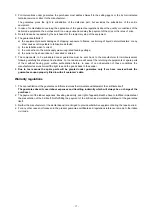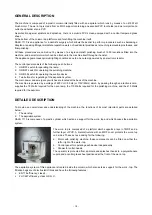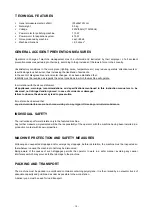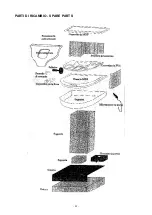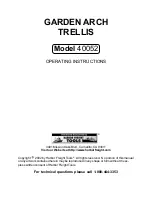
- 15 -
14. Breakaway Torque: a torque started by the motor, with the rotor locked, when powered at nominal voltage.
15. Pull-up Torque/Sagging Torque: the minimum value of a motor produced torque powered at nominal voltage, in the
speed range between zero and that of a maximum torque. .
16. Maximum Torque: produced by the motor while functioning at nominal voltage.
17. Direction of Rotation: as seen from the side of the shaft protrusion or the shaft with the largest diameter.
18. Polyphase System Voltage: the line voltage in the case of a connected 3 phase current: also known as triangular
voltage.
BEHAVIOURAL REGULATIONS
Important
To use this machine correctly and to protect the safety of assigned staff, the following general and specific regulations
must be strictly adhered to:
Operator must:
1. Respect and use with care and in the appropriate manner all safety appliances and group and individual protective
measures, which have been laid out and provided by the employer in accordance with the instructions set out in this
manual.
2. Strictly follow all orders and instructions given by the manufacturers, employer, managers and all others responsible
for individual and group safety.
3. Immediately inform the employer, managers, and those responsible for safety of any faults in the aforementioned
safety appliances, along with any other possible dangerous conditions which, in accordance with Directive
89/392/E.E.C, are defined below:
a. Danger Zone: any zone within and/or around machinery in which an exposed person is risking his health and safety.
b. Exposed Person: any person wholly or partially in a danger zone.
c.
Operator: the person or persons responsible for operating, adjusting, maintaining, cleaning, repairing or transporting
machinery.
d. P.P.E.: standing for Personal Protective Equipment - any equipment,
e. accessory or complementary object either worn or held by the worker with
f.
the purpose of protecting himself against one or more risks which could jeopardise his health and safety while at
work.
Before operating any machinery, the operator must be aware of the workings of the machine, the location of its controls
and all the machine’s functioning technical features.
Failure to use the machine in accordance with the regulations set out in this manual will result in the
manufacturers declining all responsibility for any damages to people or objects.
Other danger zones
Despite the adoption of the aforementioned accident prevention procedures which are necessary to eliminate all possible
risks to the operator, “OTHER DANGER ZONES” also exist. These areas concern the machinery’s moving parts which
may pose dangers for the operator if he were to commit an error of judgement or oversight, or use the machine not in
accordance with the s pecifications contained in this manual.
It is the responsibility of every worker, prior to commencing work, to ensure that the machinery is in full working order,
immediately informing the employer, managers, or other persons in authority of any faults or malfunctions discovered,
while striving, in the case of an emergency within his capabilities, to eliminate all potential hazards and possible faults.
The operator must never:
1.
Remove or alter
, unless otherwise authorised, the safety components, measuring apparatus, warning devices, or
the individual and group protection equipment.
2.
Carry out of his own accord
any operation or manoeuvre not within his capabilities and which could comprise the
health and safety of himself and other people.

















